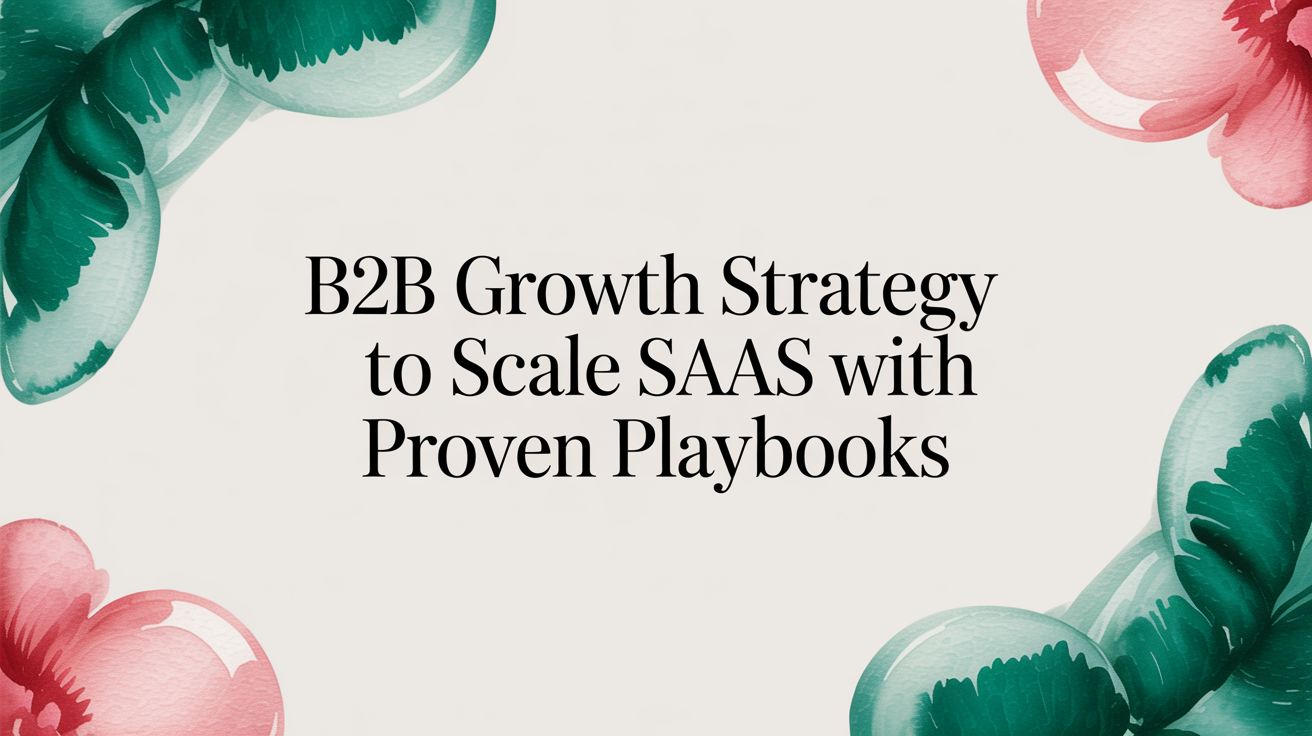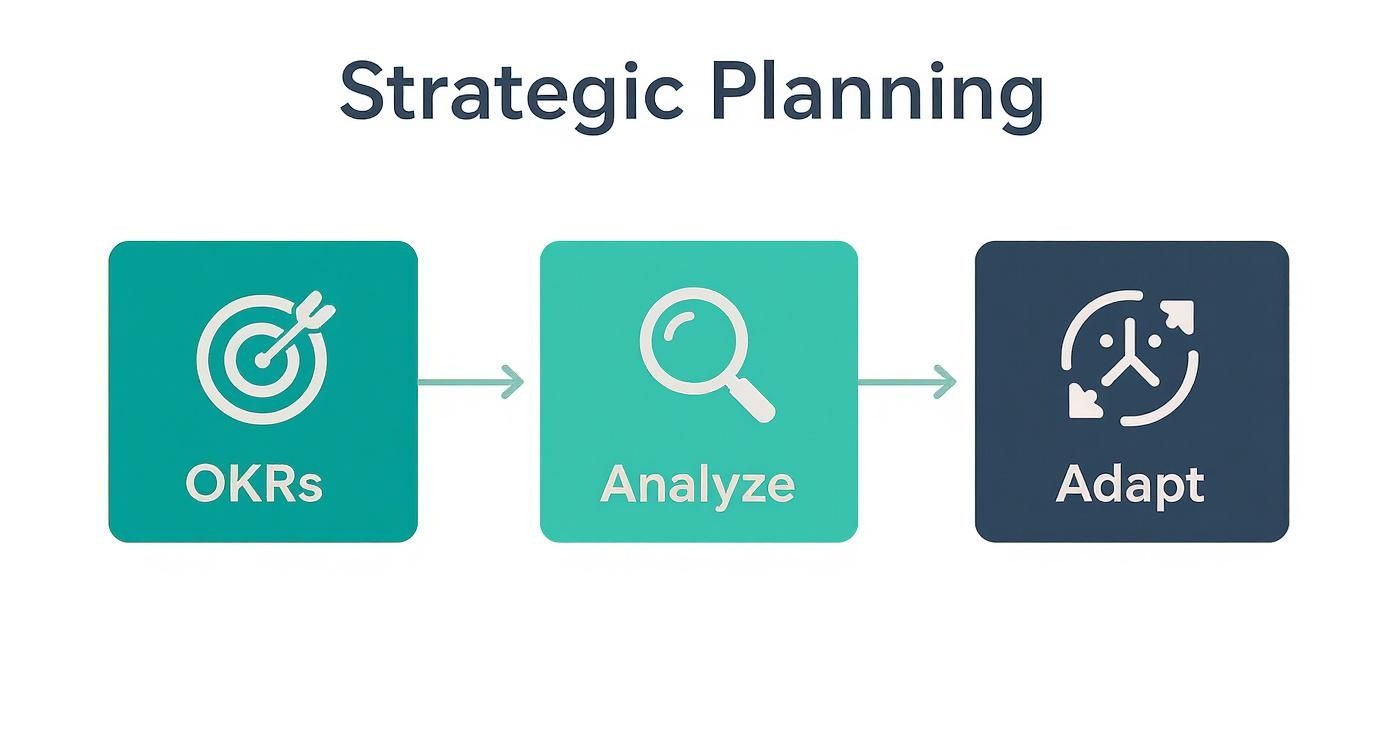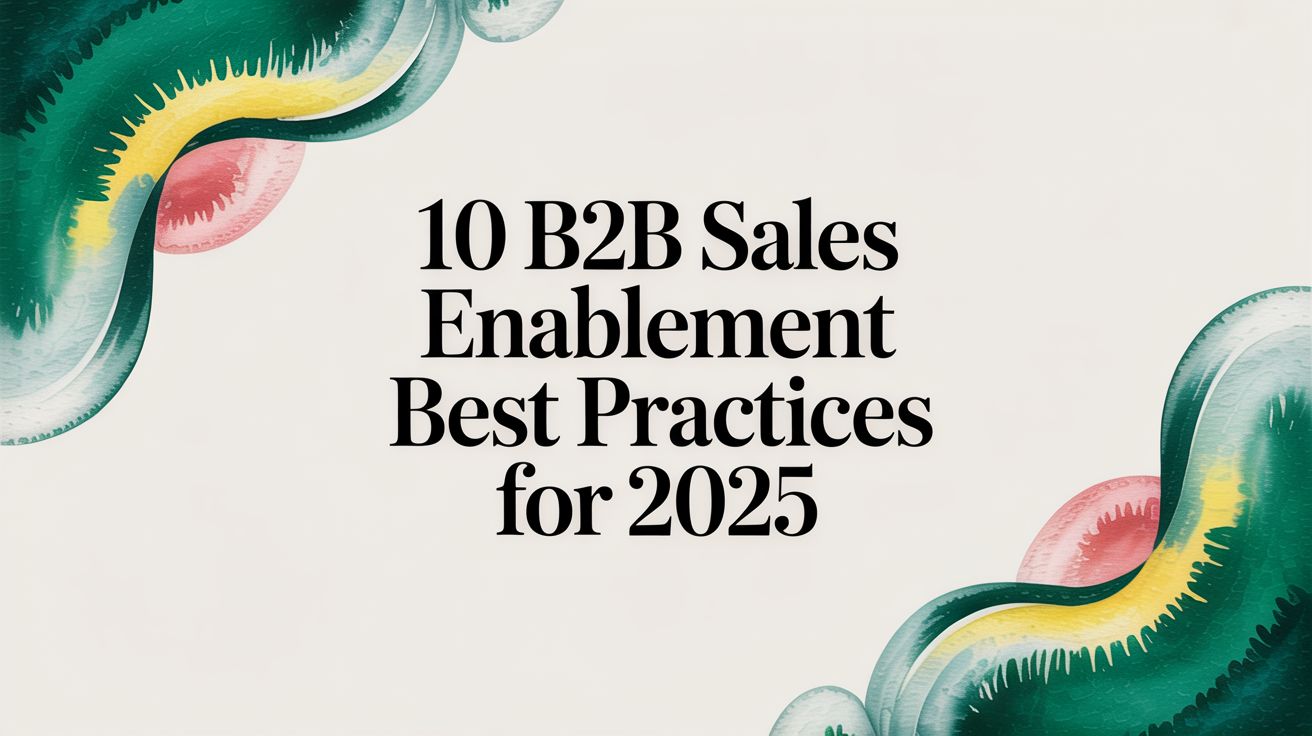B2B Growth Strategy to Scale SaaS with Proven Playbooks
November 19, 2025

Focused B2B Growth Strategy Is Your Compass.
It helps SaaS founders navigate toward predictable revenue and steady expansion.
This approach turns random deals into a repeatable revenue engine.
Why B2B Growth Strategy Is Essential

Picture your startup as a ship on a vast sea of customer needs.
A solid growth plan sets your waypoints and tells you when to trim the sails.
Without that roadmap, founders risk drifting onto hidden reefs or missing the strongest currents.
- Milestone Mapping sets clear checkpoints for launches and revenue targets.
- Flexible Tactics let you shift messaging or pricing when market winds change.
- Revenue Playbooks outline repeatable steps to turn leads into loyal customers.
For example, one SaaS team refined their messaging and saw a 25% spike in demo requests within weeks.
That small adjustment unlocked big gains in both acquisition and retention.
Charting Milestones Like Nautical Waypoints
Treat each objective as a waypoint on your map.
Plot year-end revenue goals, pilot programs, and feature rollouts in sequence.
- Define Key Outcomes each quarter.
- Assign responsibilities and set deadlines.
- Review progress at regular intervals.
“A minor shift in our microcopy boosted retention 15% in one month,” recalls a SaaS founder.
Later chapters will dive into core playbooks like segmentation, channel tests, and automation flows.
As you move through this guide, every strategic step builds momentum—steering your SaaS venture toward new growth horizons.
Next Steps On Your Growth Voyage
Ready to hoist your flag and set sail? The coming chapters unpack each playbook and the tools you need.
- Discover foundational mental models in Understanding Key Concepts.
- Master segmentation, messaging, and tooling in Core Components.
- Build multiyear plans in Strategic Planning Process.
Every chapter builds on the last, guiding you toward sustainable scaling.
Stay inspired as you captain your venture, turning insights into measurable wins that chart your path to market leadership.
Now let’s get started.
Understanding Key Concepts
B2B Growth Strategy isn’t just about chasing deals; it’s about building a predictable revenue engine.
Picture your sales pipeline as a multilane highway where leads cruise toward conversion. When one lane backs up, you simply open another to keep prospects moving.
- Leads as cars on a highway, shifting lanes to avoid congestion
- High-value accounts as a garden that flourishes with regular attention
- Recurring revenue as an engine tuned for consistent acceleration
For instance, nurturing an existing account feels like watering young seedlings—small actions today yield a bigger harvest tomorrow. Shifting from one-off wins to a steady income rhythm can transform how your entire business hums.
Key Mental Models
A straightforward growth model tracks how leads enter your system, engage over time, then expand their commitment.
Think of customer value like compound interest: tiny investments early can pay exponential dividends down the road. Charting that journey highlights exactly where to nudge potential buyers next.
“Treat growth as a system of interconnected steps, not isolated tactics.”
— Seasoned SaaS Founder
In practice, this means aligning your messaging, channels, and processes so they work together, not in silos.
Foundations Of Predictable Revenue
Digital channels let you automate touchpoints and boost customer lifetime value.
- Email drip sequences that guide prospects step by step
- Targeted ads that re-engage visitors who dropped off
- Live demos that answer questions in real time
This approach turns one-off transactions into ongoing conversations. As buyer preferences evolve, your engine must adapt on the fly.
- Monitor how leads interact with each asset
- Spot where prospects stall in demos or trials
- Adjust follow-up timing based on real engagement data
Market And Buyer Journey Influences
Market shifts and buyer paths inform every strategic move.
The global B2B eCommerce market is valued at $32.11 trillion in 2025 and is projected to hit $36.16 trillion by 2026, driven by advanced manufacturing, healthcare, and professional services embracing AI and personalized funnels. Read the full research about global B2B eCommerce market trends (https://www.sellerscommerce.com/blog/b2b-marketing-statistics/)
Such explosive growth makes digital playbooks indispensable. By studying buyer journeys, you deploy resources exactly where they’ll move the needle most.
Simple Frameworks To Revisit
Two frameworks will anchor our guide:
- Funnel Stages Map – Tracks visitors, trials, and upgrades
- Customer Journey Canvas – Links every touchpoint to revenue milestones
Keep these models front and center as you iterate. You might also refer to our product-market fit checklist to fine-tune your offer. These ideas form the bedrock for evolving from early experiments to a mature growth machine.
Putting Concepts Into Practice
When everyone speaks the same growth language, decisions get faster and handoffs smoother.
- Align sales and marketing around a unified definition of a qualified lead
- Use a shared dashboard to visualize funnel movement in real time
- Hold weekly reviews to discuss insights from your frameworks
Pick three key metrics to track each week: new opportunities, demo-to-trial rate, and expansion revenue.
Data-driven tweaks can increase pipeline velocity overnight.
As you apply these building blocks, you’ll spot leaks in your pipeline or wilt in customer engagement before they threaten your engine.
- Review heatmap data to see where visitors linger
- Survey early adopters to confirm your value propositions resonate
Next, we’ll dive into the core components that power your growth engine, step by step. Stay curious and keep measuring what matters.
Core Components Of A Growth Strategy
Every founder needs these five pillars locked down. They act as the blueprint for a reliable, repeatable revenue engine.
Customer Segmentation
Finding high-potential accounts is like charting a treasure map—you want to zero in on the X that marks the biggest prize. Start by carving your audience into clear clusters:
- Firmographics: Group by industry, company size, and location.
- Behavior: Track engagement signals to spot prospects who are warming up.
- Potential Value: Prioritize accounts that promise larger contracts or higher renewals.
Once you’ve mapped these segments, crafting targeted campaigns becomes second nature. One startup personalized outreach and saw email open rates jump by 35% in a single quarter.
Keep your segments fresh. Markets shift, data evolves, and your “treasure map” needs regular updates.
The chart below highlights how marketers allocate budgets across technology-driven growth areas.

The screenshot shows forecasted shifts in budgets toward CRM systems and content marketing.
Below is a snapshot of how B2B SaaS companies typically allocate their marketing resources:
Typical B2B Marketing Budget Allocation
This breakdown makes it clear why CRM and content remain top priorities for sustainable growth.
Value Proposition Design
Your value proposition is like forging a custom key for a specific lock—if it doesn’t fit, the door stays shut. Enterprise buyers demand iron-clad security and compliance. Mid-market teams? They want seamless onboarding and rapid time to value.
- Quantifiable Benefits such as hours saved or ROI uplift.
- Social Proof from similar companies to build trust.
- Clear Differentiators that set you apart from generic alternatives.
One founder rewrote their product headline and watched demo requests climb by 30% almost overnight. A sharp message, backed by concrete numbers, can move the needle fast.
Channel Selection
Choosing channels feels like fine-tuning an engine—you need every cylinder firing in sync to hit top speed. Match each segment with the right touchpoints:
- Direct Sales outreach for high-value accounts.
- Targeted Ads that re-engage visitors who’ve shown interest.
- Content Syndication in niche industry outlets.
Run small-scale pilots whenever you add a new channel. Test one fresh tactic each quarter—be it a podcast sponsor, a LinkedIn carousel ad, or a guest post—so you can scale winners and kill losers before they drain your budget.
Coordinating sales and marketing feels like fine-tuning an engine for peak performance.
Technology And Automation
A connected tech stack is like strapping rocket fuel to your pipeline. Integrate your CRM, email, and support systems so prospects never slip through the cracks.
- CRM Platforms centralize details and next-step reminders.
- Marketing Automation tackles repetitive drips and follow-ups.
- AI Workflows predict lead scores and recommend next actions.
One mid-market team automated their email sequences and literally halved lead-response time. They also added a chatbot on the homepage to catch after-hours interest.
Watch tool performance closely. Retire workflows that underperform, and keep your integrations humming. Linking data from HubSpot or Salesforce directly into your revenue metrics ensures insights flow freely.
Learn more about B2B marketing shifts in 2025 from this report.
Metrics Tracking
Monitoring metrics is like scanning your dashboard gauges—you spot leaks before they become floods.
- Lead Velocity Rate tracks new opportunities over a set period.
- Conversion Rate reveals how prospects move through each stage.
- Expansion Revenue measures upsells and cross-sells.
A SaaS founder we know built a simple dashboard, noticed a spike in support tickets, fixed the root issue—and churn dropped immediately.
Review these numbers weekly and share the highlights. Alignment around the same metrics keeps everyone rowing in unison.
Check out our guide on B2B SaaS Go To Market Strategy at Big Moves Marketing for deeper channel tactics.
Mastering these pillars transforms scattered efforts into a compounding engine of growth. Test relentlessly, learn from real examples, and iterate until you’ve discovered your ideal formula.
Next, we’ll guide you through shaping these components into a complete strategic plan.
Implementing Strategic Planning Process
A multiyear plan is what turns big ambitions into everyday wins.
Like plotting a road trip, you map key milestones, scan the terrain for obstacles, and adjust your course when the weather changes.
This guide walks you through each stage, so strategic planning becomes part of your B2B growth strategy, not a once-a-year ritual.
Setting Clear Objectives And Key Results
Kick off each year by choosing 3 to 5 OKRs that tie directly to revenue and product targets. Objectives describe the destination; key results mark the mileposts along the way.
- Define annual revenue goals, for example driving ARR up by 40%.
- Aim to boost customer retention by 10 points.
- Plan product wins, such as shipping two major features by Q3.
Conducting Data-Driven Market Analysis
Treat your data like a compass. Blend internal metrics with third-party insights to identify growth pockets and looming pitfalls.
- Competitor pricing reviews expose positioning gaps.
- Customer interviews surface unmet needs in each segment.
- AI-powered forecasts flag demand shifts and churn risk.
Running Scenario-Planning Exercises
Imagine the best-case, worst-case, and most-likely case. Assign each a score and sketch out tactical moves so your team can pivot quickly.
- Outline economic and industry trends that could bend your curve.
- Model budget swings under each scenario.
- Prepare contingency plans for resource shifts.
Selecting High-Impact Initiatives
With a long list of ideas, zero in on the few that will move the needle the most. Prioritization prevents resource drain and keeps ROI experiments laser-focused.
- Model each idea’s revenue lift against effort scores.
- Rank by confidence in customer adoption rates.
- Check fit with your existing OKRs and available resources.
- Pick the top two and commit to a fixed testing window.
Embedding Agile Feedback Loops
Once initiatives roll out, set a weekly check-in rhythm. Track real signals, learn fast, and iterate.
A nimble SaaS startup doubled its growth in 18 months by coaching frontline teams, trying dynamic pricing tiers, and automating outreach with AI.
Top B2B companies labeled as winners achieved twice the industry-average growth in 2024 by investing in AI, frontline coaching, deep customer segmentation, and multiyear productivity targets—while laggards fumbled under market swings and pricing pressure. Read more insights in the Bain report
The screenshot below shows performance gaps between winners and laggards across key strategic practices.
The following table contrasts how winners and laggards tackle growth planning and execution:
This comparison highlights why disciplined processes and agile practices fuel stronger performance.
Emphasizing Regular Reviews And Adaptive Roadmaps
Hold quarterly strategy reviews to measure progress against your OKRs. Then refresh your roadmap with fresh customer feedback, competitors’ next moves, and emerging demand signals.
Check out our guide on Now Next Later Roadmap to Accelerate B2B Growth for templates and best practices.
Embedding flexibility in your plan turns strategy into a living cycle of improvement and keeps teams zeroed in on impact.
Regular planning cycles separate winners from laggards by ensuring goals stay aligned with real world trends.
Using Frontline Coaching To Boost Execution
Your frontline teams are the engines of growth. Regular training and feedback loops can lift performance by up to 30%.
- Schedule weekly role-plays on objection handling.
- Replay customer calls to spotlight winning tactics.
- Set individual skill targets and chart progress.
This keeps learning continuous and strategies on track.
Applying Dynamic Pricing Models
Experiment with tiered pricing to discover the sweet spot between value and volume.
One team lifted average contract value by 25% after introducing usage-based tiers.
- Anchor premium plans with extra services.
- Use limited-time discounts to drive urgency.
These pricing tests slot neatly into your agile planning cycles and sharpen your quarterly multiyear roadmap.
By following this structured process, you’ll turn broad ambitions into daily actions.
Next, we’ll dive into real-world examples that bring these concepts to life.
Real World Application Examples
Theory can only take you so far—real wins come from rolling up your sleeves. Here, we dig into three SaaS teams that flipped challenges into momentum with a focused B2B growth playbook.
These snapshots cover everything from pinpoint segmentation to automated workflows. You’ll see how they set clear goals, acted on data, and moved the needle.
Breaking Into A New Vertical
Statera Labs once tried the same demo they used for SMBs on enterprise logistics—but the pitch fell flat. They ran a target audit, rewrote demos to focus on compliance and uptime, and retooled every slide deck.
The result? A 45% surge in qualified meetings in just six weeks.
Key Takeaways:
- Tailor language to industry terminology
- Showcase proof points from analogous sectors
- Align demos with specific compliance needs
By syncing their roadmap to vertical metrics, Statera Labs kept the momentum rolling. It’s a powerful reminder: precision in messaging pays off.
“Switching our pitch to logistics KPIs doubled our pipeline in one quarter,” recalls the CEO.
Reducing Churn With Onboarding Campaigns
StartFlow noticed mid-market customers slipping away once their free trials ended. They mapped out the first 30 days as a mini journey and automated check-ins that felt personal.
That simple structure cut churn by 30% and boosted time-to-first-success by 20%.
For practical strategies on navigating and managing expansion, you might find valuable insights on how to scale a business effectively.
These evolving touchpoints built real partnership and surfaced feedback loops to refine features and proof points.
Infographic On Strategic Planning Process
Visual thinkers, take note. Below is an infographic that breaks ongoing strategy reviews into three simple steps: setting OKRs, analyzing results, and adapting tactics.

This loop—clear objectives, regular analysis, adaptive tweaks—powers sustainable expansion. Keep each initiative rooted in data, revisit often, and adjust to hit evolving targets.
Increasing Account Value With Upsell Playbooks
VoltEdge faced pressure to grow revenue without hiring more staff. Their answer: an upsell sequence triggered by usage thresholds, paired with tailored emails for power users.
In three months, upsell revenue spiked 50%, and average contract size climbed 18%.
Steps They Followed:
- Identify high-potential accounts
- Map value milestones to product tiers
- Automate touchpoints at key usage signals
They also rolled out personalized success plans, turning top users into advocates.
Embedding rich data in upsell pitches made conversations more relevant and timely.
These case studies prove that a deliberate B2B growth strategy delivers measurable outcomes. You might be interested in our article on scaling B2B startups lessons from successful founders on growth.
What ties these stories together is a tight feedback loop between goals, data, and action. Hone your messaging, automate critical touchpoints, and watch your growth efforts compound.
Key Learnings:
- Define and revisit vertical-specific metrics to validate market expansion
- Map early experience journeys to reduce friction and boost retention
- Trigger upsells based on real usage signals to deepen customer partnerships
Embed these lessons into your own B2B growth strategy, and you’ll create a self-reinforcing engine of expansion. Now—refine your playbooks and get going.
Crafting Your Custom Growth Plan

Begin by setting a clear objective and sketching out your ideal customer segments. Inside this worksheet, you’ll find prompts to document firmographics, pain points, and decision triggers. Outlining segments first ensures every next move aligns with real user needs.
Next, sketch value propositions tailored to each group. Explain precisely how your offering solves their problems. Keep these statements punchy and include bold metrics whenever possible.
Then, pick the right outreach channels based on segment behavior and budget. Blend direct outreach, content hubs, and digital ads. Don’t try everything at once—instead, pilot one new channel each quarter.
“A focused growth plan cuts through noise and directs teams toward measurable outcomes.” — Experienced SaaS Founder
Worksheet Sections
- Segment Mapping: Record company size, role, and triggers
- Value Proposition Drafts: Match benefits with proof points
- Channel Selection Matrix: Score channels by cost and impact
- Metrics Tracker: Define targets for leads, trials, and revenue
This step-by-step layout turns theory into action. Each worksheet block builds on the last, keeping everyone on the same page.
Template Overview
Use these templates to stay on schedule and within budget. Running a session around the timeline planner in a team workshop encourages collective ownership.
When crafting your custom growth plan, developing a winning B2B content strategy will be instrumental.
Integrate content milestones alongside product and sales checkpoints.
Running Team Workshops
Run small, guided workshops to fill out each section of the worksheet. Split participants into groups to brainstorm segments and messaging. Rotate roles so everyone contributes to customer profiles and channel picks.
- Introduce objectives and tables
- Break into groups for mapping
- Reconvene to share findings and vote on priorities
This collaborative rhythm builds buy-in and often uncovers fresh ideas. Plus, swapping roles shines a light on new perspectives.
Check out our guide on building a marketing plan for more on structuring workshop agendas and templates.
Budget Tracking And Timeline
Treat your budget like a live document—allocate spend per channel and milestone. The budget tracker will show you burn rates and early ROI signals.
- Set monthly spend caps tied to milestone reviews
- Include a buffer for unexpected experiment costs
- Adjust allocations based on early results to improve ROI
Quarterly Review Checklist
At each quarterly checkpoint, compare actual performance against targets. Ask what worked, what didn’t, and agree on next quarter’s focus.
Regular reviews separate successful plans from static ones.
For example, one startup shifted 15% of its ad budget from social to search and saw a 200% lift in qualified leads over one month. Use data-driven moves like this to refine your next cycle.
Tracking Experiment Results
Log each experiment in a shared sheet to keep everyone in the loop. Include fields for:
- Hypothesis: What you expect to happen
- Duration: Test length and deadlines
- Outcome: Key numbers and qualitative feedback
- Next Steps: Scale winners, stop losers
Reviewing this sheet regularly turns scattered trials into a coherent learning hub. Over time, that database fuels smarter planning sessions and sharper budget decisions.
Your customized playbook is now ready. Assign clear owners with deadlines, then kick off execution in the first sprint for immediate impact.
Frequently Asked Questions
Below, you’ll find straightforward answers to the most common questions founders wrestle with when building a B2B Growth Strategy.
Q1: What Exactly Is A B2B Growth Strategy And Why Does My SaaS Company Need One?
Think of your growth strategy as a GPS for your revenue engine. Without it, marketing and sales often drive in different directions, leaving you with unpredictable results.
- Clarifies Roles: Marketing and sales focus on the same target accounts and personas.
- Sets Milestones: You get measurable goals at each funnel stage to see exactly where you stand.
- Creates Feedback Loops: Regular check-ins help you tweak campaigns before they stall.
In short, a solid roadmap keeps you out of the “spray and pray” trap and delivers a repeatable path to revenue.
Q2: How Do I Pick The Right Channels For My Product?
Once you’ve mapped out your strategy, channel selection is next. Start by building detailed buyer personas—what they care about, where they hang out, and what budget they command.
- Profile buyer personas by role, pain point, and buying stage.
- Match those personas to potential channels (LinkedIn, webinars, niche forums, paid search).
- Run small-scale pilots to measure cost per acquisition, conversion rates, and required effort.
Channel Selection Framework
Weight each factor against your current growth phase and budget, then prioritize the pilots that promise the best ROI.
Q3: Which Metrics Matter Most At Each Growth Phase?
You can’t improve what you don’t measure. Early on, it’s all about awareness and trial activation; later, you shift into expansion and upsell mode.
- Top-of-Funnel Reach: How many prospects know you exist?
- Trial Activation Rate: Of those who test your product, how many get value quickly?
- Paid Conversion: The percentage of trials that become paying customers.
- Expansion Revenue: Upsells and cross-sells from your existing base.
Seeing 20% of ARR come from expansion revenue is a clear signal you’ve moved beyond one-off sales.
Q4: How Can I Avoid Common Pitfalls Like Overinvesting In A Single Tactic?
It’s tempting to pour everything into the shiny new channel that’s “crushing it this week.” Instead, impose resource guardrails:
- Budget Caps: Limit spend per channel to prevent runaway costs.
- Diversify Tests: Run 3–5 simultaneous pilots rather than all your eggs in one basket.
- Stop Criteria: Define clear thresholds for when to cut a channel loose.
- Monthly Reviews: Rebalance based on performance—double down on winners, pause the rest.
These guardrails help you maintain discipline and keep your growth machine humming.
Ready to accelerate growth with proven playbooks? Partner with Big Moves Marketing and transform your SaaS scaling approach today. Let’s grow together!
%20-%20Alternate.svg)

%20-%20white.svg)